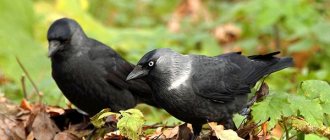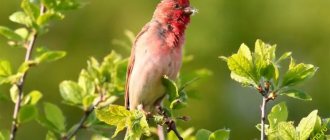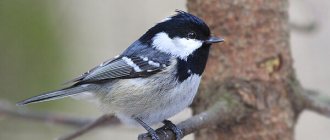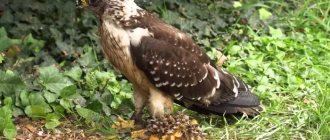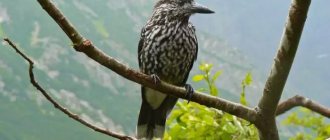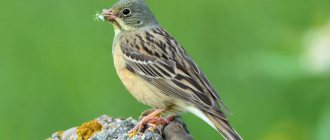Black, grayish neck. Adult jackdaws have a light iris.
Size:
Body length = 30-40cm, weight = 150-200g. From a dove.
Features:
The jackdaw differs from the crow and rook in its smaller size.
Habits:
The flight of the jackdaw is straight, with more frequent flaps than that of the rook.
Screaming bird. It lives in flocks, often together with crows and rooks. Nature of residence:
Migratory, sedentary and nomadic birds.
Source
Raven and crow, jackdaw and rook. What is the difference?
The raven is much larger than other birds; its beak is not as light as that of the rook. Crows are not found very often in the city; they like to settle on the edges of large forests, trees near river valleys and fields.
The rook is a black bird with a purple-violet tint, with a light spot without feathers at the base of the beak and in front of the head. Rooks are often found in large flocks (usually with jackdaws).
The jackdaw is black, shiny, with a gray body and sides of the head. The spot on the head is lighter, the eyes are large and blue.
The hooded crow is a black and gray bird that is in no way related to the raven, it is a separate species.
You may also be interested
Top 5 read
Certificate of the Ministry of Information of the Republic of Belarus No. 1040 dated January 14, 2010
Features of rooks
Rooks are also often confused with crows. Its color is similar to the plumage of the crook, as it has the same rich black color, shimmering with a metallic purple sheen.
The rook's beak is its main distinguishing feature. With age, in older individuals it becomes light, which does not happen with crows. In addition, the latter have a slightly larger beak.
The weight of an adult rook is 400 grams, and the body length is about 50 cm. It is larger than a jackdaw, but smaller than a crow. The rook's gait is characterized by stepping movements. And when the birds stand still, they periodically squat. Crows move by skipping, doing it gracefully and aristocratically.
Rooks lead a migratory lifestyle, so in the cold months they cannot be found in our latitudes.
Commenting Rules
These simple rules will help you enjoy communication on our website!
To ensure that your visit to our site continues to be enjoyable, we ask you to strictly follow the comment rules:
The message must not contain more than 2500 characters (including spaces)
The language of communication on the AiF website is Russian. You may use other languages in discussions only if you are confident that readers will be able to understand you correctly.
Expressions containing profanity, degrading human dignity, and inciting ethnic hatred are prohibited in comments.
Spam is prohibited, as well as advertising of any goods and services, other resources, media or events that are not related to the context of the discussion of the article.
Messages that are not related to the content of the article or the context of the discussion are not welcome.
Let's respect each other and the site where you and other readers come to chat and express their thoughts. The site administration reserves the right to delete comments or part of the comments if they do not meet these requirements.
The editors reserve the right to publish individual comments in the paper version of the publication or as a separate article on the website www.aif.ru.
If you have a question or suggestion, send a message to the site administration.
Source
Domestication and domestication
Jackdaws have been present in human life since time immemorial. Attempts to domesticate these birds continue to this day. This requires patience and is not always successful since we are talking about wild birds.
The pet needs a large space where it can fly freely. A spacious and strong enclosure is suitable for this.
As for feeding in captivity, the fledgling jackdaw will have to be fed every two hours, with crushed food and through force. The fact is that the chicks do not yet swallow food on their own. Adults at home require nutrition identical to that to which they are accustomed in the wild. This is another difficulty in keeping non-domesticated birds.
Photo source: birddatabase.com
Photo source: birddatabase.com
How to distinguish corvids.
PS: Please indicate if there are inaccuracies or typos in the post.
All my life I thought a rook was a crow, but I had no idea what a rook looked like
Moreover, the raven is not a male crow
The rook is quite easy to identify: turbines along the fuselage, low-sweep wings and tail, characteristic canopy shape, low flight speed. From afar, Rook can be mistaken for a cross with an extra crossbar.
Interesting facts
Birds have a surprisingly ringing and unique voice. Gathering in flocks, jackdaws loudly and continuously “cackle”, talking to each other.
Birds by nature are very active, cheerful, but at the same time quite distrustful and very cautious. Therefore, it is very difficult to tame an adult specimen to human hands.
Jackdaws have a phenomenal memory. They will probably remember the person who destroyed their nest, even if they were chicks. If he approaches, the bird will make a terrible fuss and behave extremely aggressively towards the offender.
Jackdaws have a piercing gaze, which is not characteristic of other representatives of the animal world. Moreover, this bird does not look away, but looks directly into your eyes. This makes the bird very photogenic, and its expression meaningful.
You will help us a lot if you share the article on social networks and like it. Thank you for that.
Subscribe to our channel.
Read more stories on the Bird at Home website.
Take care of your beaks
A group of pelicans got into a fight over fish
Greece, periphery Central Macedonia
Every year a group of about 100 pelicans arrive at Kerkini Reservoir. During such battles, birds, whose wingspan can exceed 3 meters, “fence” with their massive beaks with a loud crash.
Conclusions TheDifference.ru
- Both bird species belong to different genera of the same family.
- Magpies are more widespread than black crows.
- Crows are slightly larger than magpies.
- Both types of birds have a characteristic color.
- Birds are distinguished by the “signature” sounds they make.
Publication date: 10/02/2013
Magpies, jackdaws, rooks and crows resemble each other in appearance and lifestyle. Most of them live close to us, eat scraps and find shelter where we build our homes. Every autumn, the cities of our country are filled with black birds that make loud noises, move actively and fly in flocks. In this feathered fraternity, it is difficult to determine which species a particular bird belongs to. They all resemble crows. But there is still a difference.
Police in the US stopped a street fight between eagles
Residents of Plymouth, Minnesota called police to report a street fight. But it wasn’t people who were fighting, but two bald eagles.
Officer Mitch Martinson, who was on patrol in the area, arrived at the scene. He saw two birds lying on the roadway, their claws clutching each other.
“We have de-escalation tactics, but I've never used them on eagles or other animals,” Martinson joked to WCCO-TV.
The officer consulted with the Minnesota Department of Natural Resources and the local Raptor Center. Experts said the birds probably did not divide the territory.
Martinson tried to put makeshift hoods on the eagles' heads to calm them down. It worked: within a few minutes the birds’ claws unclenched and they flew away.
Natural enemies of jackdaws
Photo: Great Jackdaw
The jackdaw is not an easy prey. This nimble, fast bird can easily hide from an enemy in the air, hide in a crack or cave, which is possible due to its small size. However, jackdaws are no less likely than other birds to become victims of natural enemies.
Among them it is worth highlighting the following:
- predator birds. Feathered predators often attack small birds of various species, and jackdaws are no exception. Eagle owls, hawks, and golden eagles are dangerous;
- crows. They also often attack members of their own family. But most often they are engaged in destroying their nests and killing chicks;
- proteins. These small animals also destroy the nests of jackdaws when they are left unattended;
- Pets. Cats and dogs eat young animals that have not yet learned to fly. This happens to chicks whose nests are located close to human habitations;
- predatory animals. Jackdaws living in the forest often become victims of foxes, wolves, and other predators;
- parasitic microorganisms, fleas, some insects, beetles.
This group of animals does not immediately lead to the death of birds and their chicks, with rare exceptions. However, they significantly undermine their health, which ultimately significantly reduces the life expectancy of jackdaws.
Gorgeous beak from all sides
Shoebill, or royal heron (lat. Balaeniceps rex) is a bird from the pelican order, the only representative of the shoebill family (Balaenicipitidae).
A very large bird, its height on average is 1.2 m, its wingspan is 2.3 m, and its weight is from 4 to 7 kg.
It lives in the tropical swamps of East Africa, where protoptera lungfishes are found - its main food.
The wooden shoe-like beak makes the shoebill a skilled fisherman.
Unlike most other birds, the shoebill's eyes are located at the front of the skull rather than on either side, allowing it to have binocular vision. Due to the massiveness of the beak, the bird places it on its chest when resting.
Shoebill was discovered in 1849, and less than a year later it was already scientifically described.
Tokyo Safari, Yokohama, Japan
Safari park in Japan
Nutrition
Omnivorousness is a quality that helps a bird to master any conditions. The protein part of the diet consists of all types of insects and their larvae, earthworms. Less than other corvids, the jackdaw pays attention to carrion. It can destroy other people's nests, steal eggs and helpless chicks.
The plant diet is varied. It includes seeds of all herbs. Agricultural grains are preferred. Do not go unnoticed: peas, acorns, berries and so on. In cities and towns, birds are attracted to places where food waste can be found.
During feeding of jackdaws, plant foods account for 20% of the feed volume, and protein foods account for 80%. The rest of the time, the proportion changes the opposite way: 80% is vegetarian food, 20% is animal food.
In search of food, jackdaws especially like to rummage through surface debris and fallen leaves. Insects are rarely caught on bushes and trees. In areas where animals are raised, their responsibility includes manure heaps. Birds can often be seen on the backs of sheep, pigs, and cows, where they free livestock from ticks and other parasites.
Cases of “virgin breeding” of California condors discovered in the USA
Scientists intend to continue DNA analyzes in search of other non-obvious cases of parthenogenesis in birds.
A pair of California condors at the San Diego Zoo hatched from unfertilized eggs. This is the first case of parthenogenesis recorded in this bird species, the researchers reported.
Parthenogenesis (“virgin reproduction”) refers to sexual reproduction in which the formation of an embryo occurs without the participation of a male. The fetus develops from the mother's egg, receiving not half, but 100% of the genetic information from the parent. Previously, parthenogenesis was observed in lizards, Komodo dragons, chickens, turkeys, domestic pigeons and some other vertebrates. It is more common in insects and arthropods.
Scientists discovered a unique case of parthenogenesis by accident when they checked the genetic material of all California condors that lived in the zoo. This rare species is on the verge of extinction. Researchers have been conducting extensive genetic research for more than 30 years in hopes of saving these birds. Scientists saw that two condor chicks, hatched in 2001 and 2009, had DNA from their mothers.
Now these condors are no longer there. One of them died in 2003 at the age of two, and the other in 2022 at the age of eight.
Scientists intend to continue DNA analyzes in search of other non-obvious cases of parthenogenesis in birds.
Social structure and reproduction
Photo: Jackdaw bird
Jackdaws are family birds. They find a mate and live together all their lives. These animals never leave. The only exception is the death of one of the partners. The nesting period for these representatives of corvids begins in March. At this time, all pairs leave their flocks and settle in their nests. During nesting, the behavior of the animals is very touching. The male constantly takes care of his chosen one: protects her, feeds her.
In mid-spring, animals begin to build nests. They collect suitable material in the forest and on river banks. Various twigs, lumps of earth or horse manure, dog hair, grass, and scraps of paper are suitable for a jackdaw nest. In May, the couple already has eggs. The clutch usually contains no more than six eggs. The eggs of these birds are small and have a gray-bluish color.
The female usually incubates the future offspring. At this time, the male obtains food for the whole family and carefully looks after the female. The incubation period usually does not take more than nineteen days. After this time, chicks begin to emerge. They hatch completely helpless. They have no feathers or vision at all. However, the chicks develop very quickly. Their parents take care of them for less than a month. This is quite enough for the birds to grow up. Afterwards, the male and female begin to wean the young animals from the habit of begging for food. Now the chicks can begin to get their own food.
By the time they leave their parental home, young jackdaws are fully prepared for independent living. The only problem is the lack of flying skills. At first, these birds only walk and jump. During this period, animals become easy prey for predators, children, and pets. Of all the chicks, only a small number of individuals survive.
What is the difference between a crow and a jackdaw photo
home
Questions and Answers Why? For what? How? For what?
Jackdaws are ubiquitous inhabitants of city streets. They can often be seen feeding with pigeons. Like crows, these birds have been living next to humans for hundreds of years. The jackdaw (lat. Coloeus monedula), like the crow (lat. Corvus cornix), belongs to the family of corvids of the passerine order. However, in this case, what is the difference between a jackdaw and a crow ?
Jackdaw
The body of the jackdaw is tightly built. The beak is small but strong. Covered with black plumage. The lower body is black-gray, and the back of the head, sides of the head and back of the neck are ash-gray. The legs and beak are dark. Eyes with a white iris , although there are jackdaws with blue and even green eyes. An adult crow's eyes are dark brown or almost black .
Hoodie
The peculiarity of the jackdaw is its direct gaze - it is not afraid to look a person straight in the eyes . In the sun, the bird's back shines silver, and its tail and wings are metallic blue. The crow is light gray and its tail and wings are black.
The calls of the jackdaw and the crow are also different. The crow's cawing cannot be confused with anything. At the same time, both jackdaws and crows often flock together in one flock.
Source
Where does the jackdaw live?
Photo: Black Jackdaw
Jackdaws are very common animals. They are migratory birds, so they often change their habitat depending on the climate. The natural habitat includes North Africa, Western Asia, and Europe. Common jackdaws do not live in East Asia. Instead, the east is inhabited by Daurian jackdaws, which are their closest relatives. Daurian jackdaws are very similar to common jackdaws. They have a similar appearance, almost identical voice.
Common jackdaws inhabit Europe most densely. Only in the territory of a few regions such birds cannot be found. They are not found in Finland, Scandinavia, or on some islands of the Mediterranean Sea. Jackdaw is widely represented in Ukraine and Russia. This bird lives in China, Syria, Iraq, Iran, but not everywhere.
Jackdaws are migratory, living only in the north and east of their natural habitat. With the onset of cold weather, they move to the southern regions every year. Only older birds do not fly away for the winter. They usually stay in their nesting areas. The decisive factor in this case is the presence or absence of suitable food. If there is little or no food, then the old individuals simply fly closer to people. Birds that live in France, England, Denmark, Belgium, and the Netherlands also lead a sedentary lifestyle.
How to distinguish a crow from a jackdaw?
Jackdaw (Corvus monedula) Appearance: Black, grayish neck. Adult jackdaws have a light iris. Size: Body length = 30-40cm, weight = 150-200g. From a dove. Distinctive features: The jackdaw differs from the crow and rook in its smaller size.
Habits: The flight of the jackdaw is straight, with more frequent flaps than that of the rook. Screaming bird. It lives in flocks, often together with crows and rooks. Nature of residence: Migratory, sedentary and nomadic birds.
Diet: Insects (mainly beetles), seeds.
Hoodie Crow (Corvus cornix) - Appearance: Head, throat, wings, tail, beak and legs are black, the rest of the plumage is dirty gray. Size: Body length = 45-50cm, weight = 450-600g. Distinctive features: The hooded crow differs from other large corvids in being gray in color.
Carrion Crow (Corvus corone)—Appearance: Black with a bluish metallic sheen, especially on the back and wings. Size: Body length = 50-55cm, weight = 600-700g. With a gray crow. Distinctive features: The carrion crow in nature is almost indistinguishable from a young rook, but it has a thicker beak.
Large-billed Crow (Corvus levaillantii)—Appearance: Black bird with a disproportionately thick beak. Head and neck with a faint greenish sheen. Size: Body length = 45-50cm, weight = 450-600g. With a gray crow. Distinctive features: The large-billed crow differs from other ravens in its massive long beak. From the raven - smaller in size.
Source
Voice
The rook screams.
The rook's voice is drawn-out, hoarse, and bassy. Bird sounds are similar to those made by a crow. During the mating season, males do not sing sonorous songs, as other species of birds do. Regardless of the time of year, these birds “coo” and “coo.” Rooks imitate the voices of other birds and reproduce technical sounds. Birds manage to rumble like a tractor or roar like a chainsaw. From their “graa-graa” and “gaar-gaar” the name “rook” comes.
| Belarus | capercaillie |
| New Zealand | yellow-eyed penguin |
| Kazakhstan | saker falcon |
| About the author: | |
| Vladimir Shipulin - 02/23/1966, ornithologist, beekeeper, forest pathologist | |
Brief conclusions
Here are the signs by which it is easy to distinguish such birds that are similar to each other:
- Crows, unlike rooks, are monogamous;
- The raven's step is larger than that of other relatives;
- The flight of a raven is noisier due to its impressive weight;
- Magpie is the brightest and most recognizable bird of all its brothers;
- She makes specific sounds that are not characteristic of others;
- Rooks lead a migratory lifestyle, while other birds spend the winter in their homeland;
- The beak of an adult rook is light;
- Jackdaws are the smallest birds of all those represented.
By paying attention to these characteristics, you can easily determine who is in front of you.
If the article was useful to you, share the information received with your friends on social networks and leave your comments.
+11 year ago1 year agoThe crow has a black head, wings and tail, everything else is gray. The magpie has white sides (white-sided magpie), the rest of the feathers are black. There is also a raven - a larger bird, it is completely black. 2 answers:
And in size, and colors, and habits... A crow is twice the size of a magpie. It has black and gray plumage, unlike the magpie, which has black and white. The crow croaks, and the magpie makes chirping sounds. These differences are the first to catch your eye.
Plumage color. The crow is completely black, and the magpie is black and gray.
Hello, friends!
How to understand corvid birds, understand the differences once and for all? The first thing you need to pay attention to is the size. Let's start with the largest and end with the smallest corvid bird.
Crow.
Photo Yandex.
Images. The largest corvid bird. Body length 70 cm, weight 1.5 kg. Has a powerful beak and beard. Completely black as coal from the top of his head to his paws. One of the few birds that can perform aerobatics in the air, similar to aviation techniques - it does a barrel roll, a half roll.
Forest dweller, nests in rocks and trees. Avoids cities, fears people. A beautiful stately bird. Easily tamed and can talk.
Hoodie.
Three heroes at a crossroads.
Photo by the author. The most common inhabitant of cities. Body length 44-51 cm. Weight up to 750 g. Color gray-black. Begins to reproduce at the age of two years, monogamous. Builds massive nests, which birds of prey happily later occupy.
Hooded crows and a seagull eating a lamprey. Photo by the author.
Crow is a hero builder of the highest level. Extremely smart. I belong to the group of crow fans. Hitrovanki!
Black Crow.
Black Crow.
Photo Yandex. Images. I’m in my Leningrad region, and I haven’t seen any trace of it in other cities. In Russia it is found beyond the Urals in Siberia. There, on the contrary, our ordinary gray crow is a curiosity - a rare exotic. Black and hooded crows easily interbreed with each other, forming hybrids.
Rook.
On the left is a rook.
On the right are two jackdaws. Photo by the author. Slightly smaller than the hooded crow. The difference is visually completely unnoticeable. Body length 41-49 cm, weight up to 500 grams. It is all black, without exception, similar in appearance to a raven, but small compared to it. It has a wedge-shaped beak, whitish at the base in adult birds.
Rook: I’m listening to you carefully! Photo by the author.
Arrives in cities in March. It settles in clusters and forms rooks on powerful trees. There can be more than a dozen nests on one tree. Likes to visit garbage dumps. Smart and inventive.
Magpie.
Magpie on the wire.
Black-headed gull in the sky. Photo by the author. Everyone knows the white-sided magpie. Body length 44–46 cm, weight 130–290 g. The color is white and black. Has a long tail and is very careful. You can only photograph her from afar; she won’t let you get close. Loves garbage dumps, omnivore.
Jay.
Jay.
Photo by the author. One of the most beautiful corvids with large expressive eyes. Body length 32–35 cm, weight 120–200 g. Smaller than a crow, but visually this is not noticeable. Forest bird, be careful. Perfectly copies voices.
Jay. Photo by the author.
She can squeak the door, meow the cat, she has deceived me more than once. How well the starling sings! Bah, it’s the deceiving jay from above, making a mockingbird. The muzzle is laughing at me!
Jackdaw.
A jackdaw cuts an acorn.
Photo by the author. Jackdaw. Blue-eyed beauty. Photo by the author. A small bird the size of a pigeon. Body length 30–34 cm, weight 175–290. Quite common. The color is gray-black, the eyes are very light blue. He respects dumpsters very much. Smart and beautiful bird.
Kedrovka.
Kedrovka.
Photo Yandex. Images. Characteristic forest look. Body length 32–35 cm, weight 120–200 g. It can be found where there are cedar, fir, and spruce. Like all corvids, it will not refuse carrion and food waste.
Kuksha.
Kuksha.
Photo Yandex. Images. A small bird 24-30 cm long, weighing 60-100 g. It prefers spruce-fir and cedar-larch taiga. It lives deep in the forest and is difficult to see. A bright, pretty bird, monogamous, silent.
In my Leningrad region I have never seen a kush or a nutcracker. But I don’t lose hope.
You can subscribe to my channel.
General characteristics and description
The jackdaw (corvus monedula) is a medium-sized bird. The length of its body is about 39 cm including the tail. Weight does not exceed 170-280 grams. Males are slightly larger in size than females. This is the only external difference between the sexes.
The bird has a dense build, a small but strong beak. The plumage on the back is silver-gray, and the wings and tail are gray. The rest of the body is covered with black feathers.
Birds have an unusual eye color. In nature, there are jackdaws with sky-blue and even green irises.
The lifespan of birds in the wild is up to 10 years; in human hands, they will live up to 17 years. This is due to different living conditions and diets.
Photo source: flickr.com
Photo source: flickr.com
